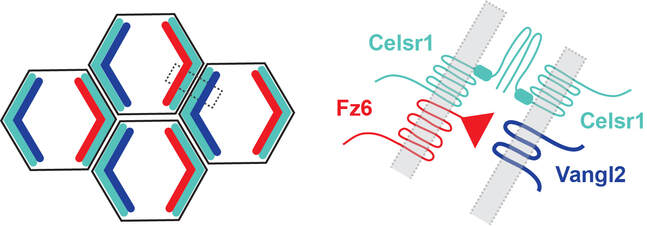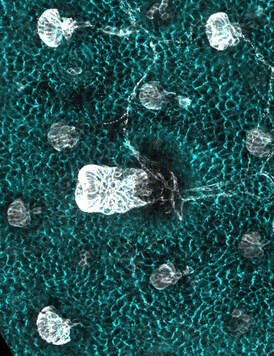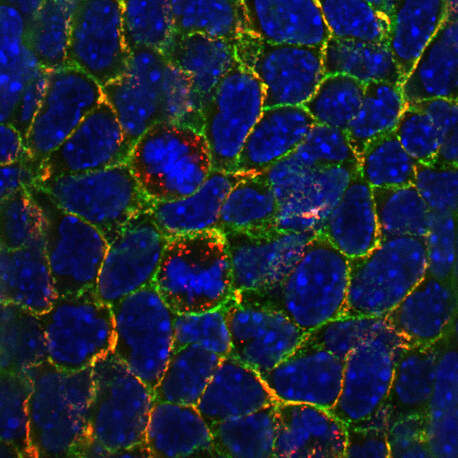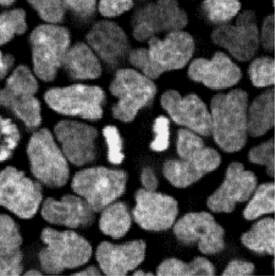Research
We seek a multiscale understanding of the mechanisms by which cells organize into local and large scale patterns and forms. Our lab focuses on development of the skin epidermis, whose pattern of regularly spaced, coordinately polarized hair follicles provides a powerful, genetically tractable and versatile mammalian model system to decipher the mechanisms of tissue morphogenesis. Because the skin is one of the most dynamic tissues in the mammalian body, we also aim to discover how epidermal architecture is maintained during proliferation and regeneration.
Patterning epithelia via the planar cell polarity pathway
A characteristic feature of most epithelia, known as planar cell polarity (PCP), is the polarization and alignment of cellular structures across a tissue plane (Devenport, 2014). PCP directs collective cell behaviors such as unidirectional cilia beating and collective cell motility, without which severe developmental abnormalities arise (Devenport, 2016), including neural tube closure defects, hydrocephalus, ciliopathies, deafness and congenital heart defects. Our goal is to decipher how cells integrate global directional cues and local cell communication to generate PCP in the skin epidermis and other epithelial tissues. Currently we are working towards, 1) deciphering the molecular architecture of intercellular PCP complexes; 2) identifying long-range directional cues (Aw et al., 2016; Aw and Devenport, 2017; Cetera et al., 2017) for planar polarity; and 3) defining the mechanisms of PCP self-organization and spontaneous polarization (Aw et al., 2016).
Mechanisms of collective cell motion by the planar cell polarity pathway
|
PCP is evident in a vast array of diverse epithelial structures, from simple protrusions that emanate from individual cells, such as Drosophila wing hairs to elaborate multicellular structures such as mammalian hair follicles (Devenport and Fuchs, 2008). How the principals governing polarization of individual cells apply to complex multicellular structures was unknown. We found that the polarization of multicellular hair placodes is driven by dramatic cell rearrangements coordinated in a counter-rotational pattern of cell flow (Cetera et al., 2018). These movements displace centrally-positioned cells forward to lead placode growth, while sweeping outer cells in the opposite direction toward the placode rear. Strikingly, this pattern of cell rearrangements generates not only the morphological polarization of the hair follicle, but also establishes the planar polarized organization of progenitor fates upon which the future hair follicle is built. Current research focuses on understanding how upstream signals that specify placode fate cooperate with PCP-dependent cytoskeletal reorganization to polarize collective cell motion.
|
Cell cycle regulation of cell polarity
|
During cell division polarized epithelial cells employ mechanisms to preserve cell polarity and tissue integrity. We discovered in dividing cells of the mammalian skin, PCP is maintained via bulk internalization, partitioning, and redelivery of cortical PCP proteins (Devenport et al., 2011). The dramatic redistribution of PCP proteins coincides precisely with cell cycle progression, and our work revealed a molecular mechanism by which the cell cycle machinery directly regulates cargo-specific endocytosis to coordinate cell polarity with mitotic progression (Shrestha et al., 2015).
Given the intercellular adhesive interactions between PCP components, we investigated the how mitotic internalization affects the PCP proteins of neighboring cells. We showed that rather than disassembling prior to internalization, intercellular Celsr1 homodimers are trans-endocytosed into dividing cells (Heck et al., 2017). Like Celsr1, Fz6, and Vangl2 are internalized from neighbors demonstrating that dividing cells endocytose not only their own PCP proteins but rather, intact intercellular PCP complexes. Our current goal is to decipher how cells restore polarity after they divide. |
Regulation of stem cell fate decisions by cell shape and tissue architecture
|
How cells balance differentiation and growth to form organs of the right size and correct architecture is a fundamental but still poorly understood question in developmental biology and regenerative medicine. Through oriented cell divisions, a stem cell can position its daughters to facilitate tissue expansion, establish multiple cell layers, or generate asymmetric cell fates. We aim to understand how stem cells choose between self-renewing divisions and those that generate differentiated daughters, and how local tissue architecture feeds back on division orientations to ensure they meet the needs of the tissue (Box et al., 2019).
|



